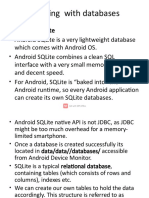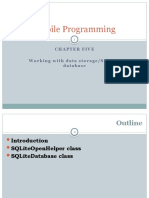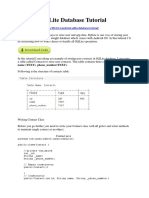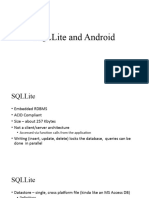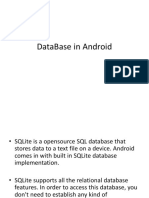0% found this document useful (0 votes)
291 views17 pagesAndroid Sqlite Tutorial - Javatpoint
The document discusses using SQLite as an embedded database on Android devices, including creating a SQLiteOpenHelper class to manage the database and performing CRUD (create, read, update, delete) operations. It provides code examples for creating a Contact class to store contact data, a DatabaseHandler class that extends SQLiteOpenHelper to implement database functionality, and methods to add, get, update, and delete contact records from the database.
Uploaded by
ravichauhanis420Copyright
© © All Rights Reserved
We take content rights seriously. If you suspect this is your content, claim it here.
Available Formats
Download as PDF, TXT or read online on Scribd
0% found this document useful (0 votes)
291 views17 pagesAndroid Sqlite Tutorial - Javatpoint
The document discusses using SQLite as an embedded database on Android devices, including creating a SQLiteOpenHelper class to manage the database and performing CRUD (create, read, update, delete) operations. It provides code examples for creating a Contact class to store contact data, a DatabaseHandler class that extends SQLiteOpenHelper to implement database functionality, and methods to add, get, update, and delete contact records from the database.
Uploaded by
ravichauhanis420Copyright
© © All Rights Reserved
We take content rights seriously. If you suspect this is your content, claim it here.
Available Formats
Download as PDF, TXT or read online on Scribd
/ 17









